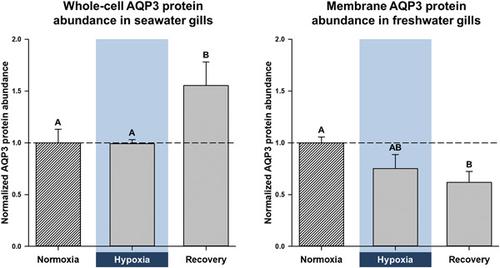当前位置:
X-MOL 学术
›
J. Exp. Zool. Part A
›
论文详情
Our official English website, www.x-mol.net, welcomes your
feedback! (Note: you will need to create a separate account there.)
Is aquaporin-3 involved in water-permeability changes in the killifish during hypoxia and normoxic recovery, in freshwater or seawater?
Journal of Experimental Zoology Part A ( IF 1.9 ) Pub Date : 2020-06-17 , DOI: 10.1002/jez.2393 Ilan M Ruhr 1 , Chris M Wood 1, 2, 3 , Kevin L Schauer 1 , Yadong Wang 1 , Edward M Mager 1 , Bruce Stanton 4 , Martin Grosell 1
Journal of Experimental Zoology Part A ( IF 1.9 ) Pub Date : 2020-06-17 , DOI: 10.1002/jez.2393 Ilan M Ruhr 1 , Chris M Wood 1, 2, 3 , Kevin L Schauer 1 , Yadong Wang 1 , Edward M Mager 1 , Bruce Stanton 4 , Martin Grosell 1
Affiliation

|
Aquaporins are the predominant water‐transporting proteins in vertebrates, but only a handful of studies have investigated aquaporin function in fish, particularly in mediating water permeability during salinity challenges. Even less is known about aquaporin function in hypoxia (low oxygen), which can profoundly affect gill function. Fish deprived of oxygen typically enlarge gill surface area and shrink the water‐to‐blood diffusion distance, to facilitate oxygen uptake into the bloodstream. However, these alterations to gill morphology can result in unfavorable water and ion fluxes. Thus, there exists an osmorespiratory compromise, whereby fish must try to balance high branchial gas exchange with low ion and water permeability. Furthermore, the gills of seawater and freshwater teleosts have substantially different functions with respect to osmotic and ion fluxes; consequently, hypoxia can have very different effects according to the salinity of the environment. The purpose of this study was to determine what role aquaporins play in water permeability in the hypoxia‐tolerant euryhaline common killifish (Fundulus heteroclitus), in two important osmoregulatory organs—the gills and intestine. Using immunofluorescence, we localized aquaporin‐3 (AQP3) protein to the basolateral and apical membranes of ionocytes and enterocytes, respectively. Although hypoxia increased branchial AQP3 messenger‐RNA expression in seawater and freshwater, protein abundance did not correlate. Indeed, hypoxia did not alter AQP3 protein abundance in seawater and reduced it in the cell membranes of freshwater gills. Together, these observations suggest killifish AQP3 contributes to reduced diffusive water flux during hypoxia and normoxic recovery in freshwater and facilitates intestinal permeability in seawater and freshwater.
中文翻译:

在淡水或海水中,在缺氧和常氧恢复期间,水通道蛋白 3 是否与鳉鱼的水渗透性变化有关?
水通道蛋白是脊椎动物中主要的水运输蛋白,但只有少数研究调查了鱼的水通道蛋白功能,特别是在盐度挑战期间调节水渗透性。对缺氧(低氧)条件下的水通道蛋白功能知之甚少,这会严重影响鳃功能。缺氧的鱼通常会扩大鳃表面积并缩小水与血液的扩散距离,以促进氧气进入血流。然而,鳃形态的这些改变会导致不利的水和离子通量。因此,存在渗透呼吸妥协,鱼必须尝试平衡高鳃气体交换与低离子和水渗透性。此外,海水和淡水硬骨鱼的鳃在渗透通量和离子通量方面具有显着不同的功能;因此,根据环境的盐度,缺氧会产生非常不同的影响。本研究的目的是确定水通道蛋白在耐缺氧广盐性鳉鱼的水渗透性中起什么作用。Fundulus Heteroclitus),在两个重要的渗透调节器官——鳃和肠。使用免疫荧光,我们将水通道蛋白 3 (AQP3) 蛋白分别定位于离子细胞和肠细胞的基底外侧膜和顶端膜。尽管缺氧会增加海水和淡水中鳃 AQP3 信使 RNA 的表达,但蛋白质丰度并不相关。事实上,缺氧并没有改变海水中 AQP3 蛋白的丰度,而是减少了淡水鳃细胞膜中的 AQP3 蛋白丰度。总之,这些观察结果表明,鳉鱼 AQP3 有助于减少淡水中缺氧和常氧恢复期间的扩散水通量,并促进海水和淡水中的肠道通透性。
更新日期:2020-06-17
中文翻译:

在淡水或海水中,在缺氧和常氧恢复期间,水通道蛋白 3 是否与鳉鱼的水渗透性变化有关?
水通道蛋白是脊椎动物中主要的水运输蛋白,但只有少数研究调查了鱼的水通道蛋白功能,特别是在盐度挑战期间调节水渗透性。对缺氧(低氧)条件下的水通道蛋白功能知之甚少,这会严重影响鳃功能。缺氧的鱼通常会扩大鳃表面积并缩小水与血液的扩散距离,以促进氧气进入血流。然而,鳃形态的这些改变会导致不利的水和离子通量。因此,存在渗透呼吸妥协,鱼必须尝试平衡高鳃气体交换与低离子和水渗透性。此外,海水和淡水硬骨鱼的鳃在渗透通量和离子通量方面具有显着不同的功能;因此,根据环境的盐度,缺氧会产生非常不同的影响。本研究的目的是确定水通道蛋白在耐缺氧广盐性鳉鱼的水渗透性中起什么作用。Fundulus Heteroclitus),在两个重要的渗透调节器官——鳃和肠。使用免疫荧光,我们将水通道蛋白 3 (AQP3) 蛋白分别定位于离子细胞和肠细胞的基底外侧膜和顶端膜。尽管缺氧会增加海水和淡水中鳃 AQP3 信使 RNA 的表达,但蛋白质丰度并不相关。事实上,缺氧并没有改变海水中 AQP3 蛋白的丰度,而是减少了淡水鳃细胞膜中的 AQP3 蛋白丰度。总之,这些观察结果表明,鳉鱼 AQP3 有助于减少淡水中缺氧和常氧恢复期间的扩散水通量,并促进海水和淡水中的肠道通透性。











































 京公网安备 11010802027423号
京公网安备 11010802027423号